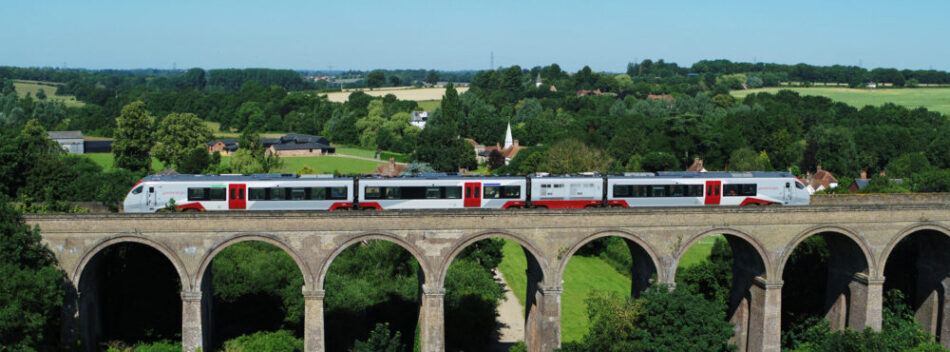Greener new trains cutting carbon emissions in East Anglia
November 8, 2021

Aerodynamic fronts, lighter chassis and brakes which return energy back to the network are some of the features of Greater Anglia’s new trains which are making train travel even more sustainable.
In the run-up to transport day at COP26, Greater Anglia is highlighting the environmental benefits of its new trains.
The train company is replacing all its old trains with brand new trains. New trains are already operating all services on many routes including the intercity, Stansted Express and regional lines.
Taking more cars off the road
The new trains are longer with more seats, which means that they can carry more passengers and take even more cars off the road – preventing tonnes of harmful C02 emissions being released into the atmosphere as well as reducing congestion.
One of Greater Anglia’s full intercity trains potentially takes up to 504 cars off the road, while a new four carriage bi-mode train removes 152 cars and a three carriage bi-mode train removes 111. The company’s new five-carriage electric commuter train take up to 362 cars off the road – or 725 when they run as 10 carriages.
People can check how they much they can reduce their carbon emissions by swapping a car journey for the train on Greater Anglia’s carbon calculator at greateranglia.co.uk/carbon-calculator.
The new trains themselves have many green features which benefit the environment and are helping individuals and businesses drive down their carbon consumption.
Greener diesel trains
Bi-mode trains, which run on electricity and diesel, have replaced every single one of Greater Anglia’s old diesel trains, which ran on diesel only. They have been future-proofed so that they could at some point run on battery power instead of diesel.
The bi-mode trains, made by Swiss manufacturer, Stadler, meet modern emissions standards which help to reduce nitrogen oxide emissions from diesel engines. By injecting “AdBlue” into the exhaust it converts the nitrogen oxide to nitrogen and water vapour, which reduces nitrogen oxide particles caused by exhaust emissions from being released into the atmosphere.
When running in diesel mode, the trains’ onboard tech enables trains to be driven without powering up all of the two or four diesel engines. Drivers can also use “coast mode” to drive the train without drawing on power – either electric or diesel, due to highly efficient and powerful motorisation. These features all contribute to the trains using the minimum amount of energy possible.
Even in diesel mode, the trains can brake electrically – generating electricity which can be used to power the on-train systems such as heating and lighting, rather than powering up diesel engines and using more fuel. In addition, this also means there are fewer brake pads used so less dust is produced and released into the environment.
The bi-mode trains generate electricity for the motors, making them more efficient than the traditional diesel-mechanical trains they replaced, which have higher energy losses in transferring power from the engine to the wheels.
Creating power through braking
All Greater Anglia’s new trains have “regenerative braking”. This harnesses energy produced by braking and returns it to the power network. The company’s new intercity and Stansted Express electric trains can generate more instantaneous power when braking than they need while accelerating.
Lighter and computer intelligence
The new electric trains are lighter, made from aluminium instead of steel, and their fronts are more aerodynamic and streamlined than the more boxy or flat fronts of the old trains – all of which contributes to energy efficiency, especially when trains are travelling at top speed.
The bogies on Greater Anglia’s new Alstom commuter trains – the framework which attaches the wheels to the train’s undercarriage – is an innovative design, 30 per cent lighter than previous bogies and reducing aerodynamic drag on the trains.
LED lights are standard throughout new trains, and on Greater Anglia’s new Alstom electric commuter trains, which have an “eco mode” to make energy consumption as efficient as possible, the lights dim and brighten depending on outside light, saving further electricity.
Energy-saving intelligent computer systems also actively monitor the trains’ maintenance status, reducing the need for unnecessary maintenance saving cost and energy.
All Greater Anglia’s new trains have “hibernation” or “intelligent stabling” which reduces power usage by switching off lights and heating and ventilations systems, only switching back on for passenger service or in certain conditions such as very low temperatures.
Built to last but recyclable when reach end of service life
When the new trains reach the end of their life, which is not expected to be until the 2060s, they have been built so that nearly all components can be recycled, further reducing their carbon footprint.
Martin Beable, Greater Anglia’s engineering director, said: “New trains are built to last. Some of our old trains were over 45 years old. If our new fleet could be running around the rail network for the next 45 years, it’s important that they are as kind to the environment as possible and designed to help us embrace future technological developments too – such as improvements in battery power.
“Rail travel is the most sustainable form of transport after walking and cycling, and we are keen to make it even more sustainable, by running more energy-efficient trains and cutting our carbon emissions.
“Climate change is of growing importance to our customers and we are keen to do our bit to help combat it and also contribute to a better environment and less air pollution in the communities we serve.”
Timetable improvements, more Sunday services on some routes and the improved punctuality new trains bring, combined with the new trains’ green features make rail travel an even more sustainable and attractive alternative to the car.
To find out what else Greater Anglia is doing to reduce carbon and promote biodiversity at stations, or to discover how the train company can help businesses and organisations in the area meet their carbon emissions targets, visit greateranglia.co.uk/greeneranglia